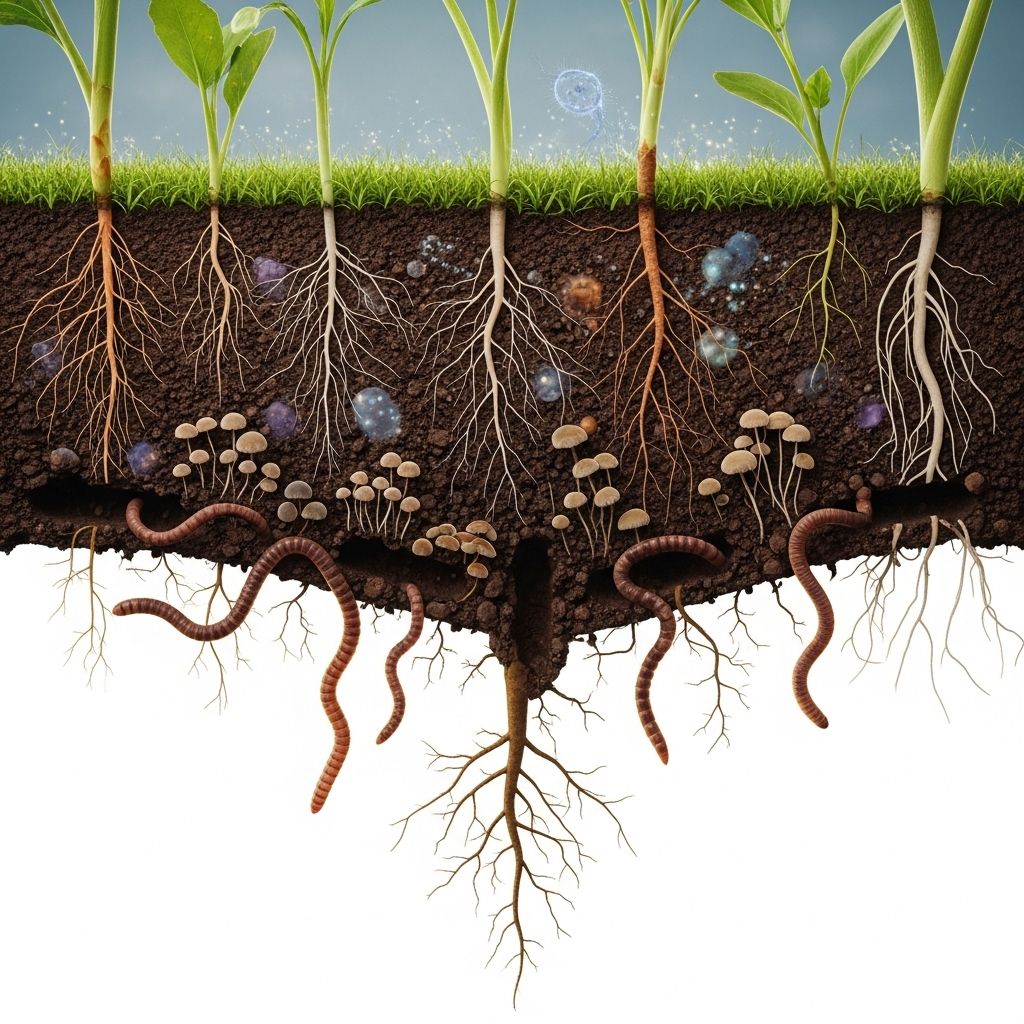Innovative Businesses and Products Enhancing Soil Biodiversity
How companies, coalitions, and products are catalyzing soil biodiversity restoration and shaping a sustainable future for agriculture.

Soil biodiversity is the foundation of resilient ecosystems, supporting healthy crops, carbon sequestration, water retention, and pest control. In a world grappling with climate change and food insecurity, forward-looking businesses are increasingly investing in strategies, coalitions, and products aimed at restoring and protecting soil biodiversity. This article explores the dynamic intersection of sustainable business innovation, collaborative coalitions, and product development—all dedicated to nurturing life beneath our feet.
Why Soil Biodiversity Matters
Soil is more than dirt—it’s a living ecosystem teeming with microorganisms, fungi, insects, and other wildlife. These organisms
—from bacteria to earthworms— help:
- Decompose organic matter, enriching the soil with nutrients.
- Control pests and diseases through natural biocontrol mechanisms.
- Regulate water cycles and increase resilience to climate hazards.
- Enhance plant health and boost crop yields.
Threats like excessive chemical use, over-tilling, and monoculture farming jeopardize soil biodiversity, negatively affecting productivity and ecosystem health.
Business Coalitions Championing Soil Biodiversity
Collaborative business initiatives have emerged as powerful drivers for soil health. Prominent among them:
One Planet Business for Biodiversity (OP2B)
- OP2B is an international coalition of companies focused on restoring biodiversity within agricultural value chains.
- Action is centered on three pillars:
- Scaling up regenerative agriculture: Moving away from conventional farming to practices that renew soil life.
- Enhancing cultivated biodiversity: Promoting diversified crops and farming methods.
- Protecting high-value ecosystems: Safeguarding critical ecological habitats threatened by expansion.
- OP2B leverages collaboration and innovation, creating new market opportunities while diversifying supply chains and reducing vulnerability to shocks.
This approach builds resilience against catastrophic events and adapts to evolving consumer demands, making biodiversity a central business strategy.
Bain & Company’s Nature and Biodiversity Playbook
- Bain identifies regenerative agriculture as one of five key movements for biodiversity.
- Highlight: General Mills’ commitment to regenerative farming—1 million acres targeted by 2030, with research showing a $1 to $5 return-on-investment in social, environmental, and economic value.
- Initiatives include purchasing regenerative wheat, emission and water quality tracking, and carbon credit programs.
- Corporate supply chain innovation—e.g., IKEA’s sourcing of 98% FSC-certified or recycled wood and Nestlé’s satellite monitored reforestation—shows biodiversity-positive business transformation.
Products and Services Supporting Soil Biodiversity
Innovative products play an essential role in restoring soils. Companies develop solutions such as:
- Biological inputs—biofertilizers, bioherbicides, and inoculants that stimulate beneficial soil organisms, reduce dependence on synthetic chemicals, and enhance long-term soil fertility.
- Organic soil amendments—compost, worm castings, and mycorrhizal inoculants add life and structure to soil, promoting microbial activity and plant health.
- Sensors and monitoring technology—tools that help farmers make data-driven decisions about soil health, moisture, and biodiversity, optimizing input use and limiting disturbance.
- Regenerative processed foods—companies like General Mills, Danone, and Nestlé are investing in sourcing ingredients from regenerative systems, supporting biodiversity at the farm level.
Regenerative Agriculture: Principles and Impact
Regenerative agriculture is the centerpiece for most biodiversity-supporting business initiatives.
- Reduces tillage—leaving soil structure intact boosts microbial life.
- Prioritizes cover crops and crop rotation—these prevent erosion, fix nutrients, and encourage diversity.
- Minimizes synthetic chemical use—using fewer pesticides and fertilizers helps soil organisms thrive.
- Integrates livestock, managed grazing, and agroforestry—animal manure and tree cover further enrich soils.
- Results: Greater soil fertility, resilience to climate shocks, more nutritious food, enhanced water retention, and carbon sequestration.
Case Study Table: Regenerative Business Commitments
| Company | Initiative | Biodiversity Impact |
|---|---|---|
| General Mills | Regenerative agriculture for 1 million acres by 2030 | Improved soil health, reduced emissions, diversified farm ecosystems |
| IKEA | 98% FSC-certified or recycled wood sourcing | Deforestation reduction, ecosystem protection |
| Nestlé | Satellite monitored reforestation, climate-smart sourcing | Forest ecosystem restoration, climate adaptation |
| OP2B Members | Cross-sectoral biodiversity collaborations | Diversified crops, scaled-up regeneration, systemic change |
Business Strategies for Sustaining Soil Biodiversity
- Agroecology: Integrating ecological principles into farming systems, reducing synthetic input reliance, promoting crop diversity, and natural pest control.
- Redirecting subsidies: Shifting financial incentives away from chemical-intensive practices toward regenerative, biodiversity-supporting systems.
- Indigenous knowledge and community empowerment: Incorporating centuries-old land management wisdom for sustainable solutions.
- Landscape-scale planning: Connecting protected areas with working lands for coordinated restoration.
- Climate-smart ecosystem restoration: Adapting restoration practices for ongoing climate change impacts, ensuring long-term viability.
Key Ecosystem Services Provided by Soil Biodiversity
- Crop pollination.
- Natural pest regulation.
- Carbon sequestration and climate mitigation.
- Clean water filtration and flood control.
Blue Carbon Ecosystems and Business Opportunity
Blue carbon ecosystems, such as mangroves, seagrasses, and salt marshes, capture and store atmospheric carbon—often at much higher rates than terrestrial systems. Their restoration helps:
- Mitigate climate change through large-scale carbon sequestration.
- Support rich coastal biodiversity.
- Protect shorelines against storms and rising seas.
Businesses investing in coastal ecosystem protection not only contribute to climate action but also enhance biodiversity, water quality, and community resilience.
Restoration Initiatives and Success Stories
Business-Led Restoration
Companies are making tangible contributions to soil restoration by:
- Funding farmer training and technical support for regenerative methods.
- Developing direct relationships with producers to ensure adoption of biodiversity-friendly practices.
- Launching carbon credit programs that reward farmers for measurable outcomes.
- Monitoring progress with advanced satellite and sensor technology.
Policy and Advocacy
- Coalitions are advocating for government subsidies and policies that favor biodiversity restoration.
- Engagement with international frameworks and standards to encourage alignment across industries.
Challenges and Next Steps
Despite growth in business participation, key challenges remain:
- Scaling impact: Many projects are still pilot-scale. Full adoption across regions and supply chains is needed.
- Measurement and certification: Reliable tools for tracking biodiversity gains are lacking in many areas.
- Economic pressure: Farmers and businesses need enduring financial incentives for ongoing change.
- Education: Widespread knowledge gaps prevent optimal soil management.
Businesses, policymakers, and consumers must collaborate for systemic change. Continued innovation, public engagement, and investment in soil-friendly products are critical to making biodiversity restoration a reality.
Frequently Asked Questions (FAQs)
Q: What is soil biodiversity and why is it important?
A: Soil biodiversity includes the wide variety of living organisms in the soil, such as bacteria, fungi, earthworms, and insects. These organisms are responsible for decomposing organic matter, improving soil structure, controlling pests, and supporting plant health—ensuring resilient, productive agricultural systems.
Q: How do businesses support soil biodiversity?
A: Businesses support soil biodiversity by investing in regenerative agriculture, funding research and farmer education, sourcing sustainably, developing biodiversity-friendly products (like biofertilizers), and collaborating through coalitions focused on transformative systemic change.
Q: What are examples of products that restore soil biodiversity?
A: Examples include organic composts, biological pest controls, microbial soil inoculants, and regenerative food brands sourcing from biodiverse farms. Technical innovations like soil health sensors and satellite monitoring also play key roles.
Q: How does regenerative agriculture differ from conventional farming?
A: Regenerative agriculture prioritizes rebuilding soil health and biodiversity over yield maximization. It uses minimal chemicals, practices crop rotation, grazes animals strategically, and restores natural habitats, resulting in more resilient food systems and ecosystems.
Q: Why are coalitions important for scaling up soil biodiversity restoration?
A: Coalitions unite businesses, producers, NGOs, and policymakers toward common goals, amplifying resources and driving market-wide change faster than isolated efforts. They help set standards, create incentive programs, and share research advancements.
Conclusion: Future Trends and Opportunities
Soil biodiversity restoration is at the heart of a sustainable future for food systems, climate action, and resilient communities. As more businesses join coalitions, evolve products, and refine practices, the world edges closer to healthier soils underpinning thriving ecosystems. The synergy between business innovation and ecological restoration represents hope not just for agriculture, but for global biodiversity and environmental stability.
References
- https://www.bain.com/insights/the-nature-and-biodiversity-playbook-for-business/
- https://www.globalstewards.org/sustainable-business-ideas-environmental-solutions.htm
- https://www.wbcsd.org/actions/one-planet-business-for-biodiversity-op2b/
- https://www.decadeonrestoration.org/stories/soil-biodiversity-contributions-and-threats
- https://www.ramboll.com/galago/15-businesses-leading-the-way-for-biodiversity-and-target-15-implementation
- https://www.nestle.com/sustainability/nature-environment/regenerative-agriculture
- https://eeb.ku.edu/news/article/soil-health-is-big-business-but-ku-researchers-say-many-fungal-products-dont-work-as-promised
- https://www.spglobal.com/sustainable1/en/insights/special-editorial/how-the-world-s-largest-companies-depend-on-nature-and-biodiversity
- https://ensia.com/features/business-coffee-plant-biodiversity/
Read full bio of medha deb












